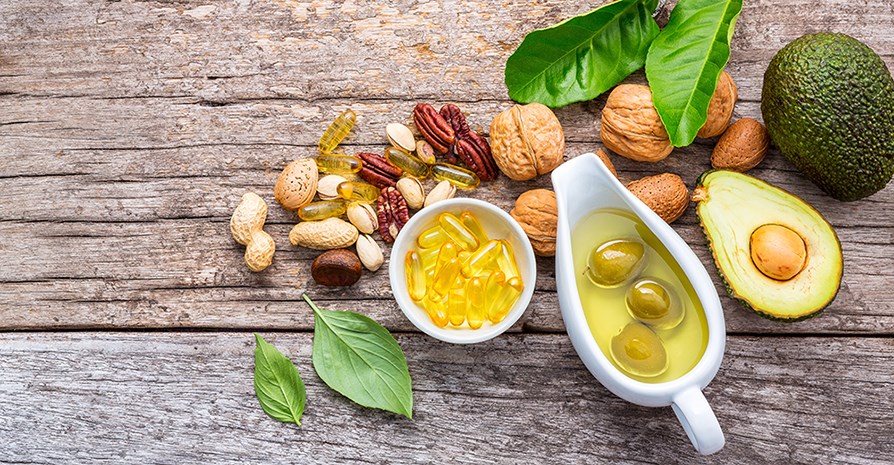Fatty Acids
Fat has always been a hot topic when it comes to our diet, and the pendulum swings both ways, sometimes equating fat to the work of the devil and sometimes to manna from heaven. Meanwhile, certain specific fatty acids have received more attention than others. These include, for example, saturated fats, trans fats, and polyunsaturated fats in general, but omega-3 fats in particular. However, fat has a number of life-sustaining functions and we could definitely not survive without fat.
- Why do you need fat?
- How much fat do you need?
- What types of fats can benefit you?
Why do you need fat?
Fat is an energising nutrient that gives you twice the amount of energy as carbohydrates and protein. It is therefore a great energy reserve, since it is rich in energy without binding fluid like carbohydrates. In addition, the amount of energy that can be stored in the form of fat is basically unlimited. A person weighing 80 kg with 15% body fat has a fat mass of 12 kg. This means a storage capacity of over 100,000 kcal.
However, it is carbohydrates, and not fat, that is primarily used as fuel in physical activity. It would be optimal if fat was used primarily as an energy source in physical activity, since fat stores would last for at least 1,300 km of running. With improved fitness, you can get better at utilising fat as energy, especially the fat that is stored in your muscles.
Fat is also a key component of your cells. Some of these structural proteins cannot be produced by your body itself; instead, they have to be added through your diet. Proteins like these are collectively referred to as essential fatty acids. Fat is also required for you to absorb fat-soluble vitamins, such as vitamin A, D, E, and K. In addition, fat provides insulating material so that you can maintain your body temperature in low temperatures. Fatty tissue also serves as mechanical protection for your internal organs. How much fat do you need?
According to Swedish Nutrition Recommendations, the percentage of fat in our diet should be between 25-35 energy percent (E%). The need for fat mainly consists of the need for essential fatty acids, omega-3, and omega-6. Typically, however, it is only the intake of omega-3 that is inadequate. The general recommendation is that 0.5% of the total energy intake should be omega-3 fatty acids.

Effective fatty acids
Because of their specific properties, some fatty acids have received more attention than others. The most noted fatty acid is probably the essential omega-3 fatty acid. It forms the basis for the anti-inflammatory eicosanoids. It also has positive effects on the heart and vessels; something that was first noticed by the Eskimos on Greenland. The most significant effect is the ability of omega-3 fatty acids to reduce the risk of arrhythmia, but they have also been shown to help aggregate platelets, lower blood lipid levels, increase HDL cholesterol (also referred to as the good cholesterol), lower LDL cholesterol (also referred to as the bad cholesterol), and reduce blood pressure.
The omega-6 fatty acid is an essential fatty acid that forms the basis for pro-inflammatory eicosanoids.
Omega-3 & omega-6
What determines whether the net effect is pro-inflammatory or anti-inflammatory is the ratio between these two fatty acids. You should therefore make sure to eat oily fish, such as salmon, at least three times a week, or use a supplement. Linseed oil also contains omega-3 fatty acids and is a good vegetarian option. The omega-3 fatty acid alpha-linoleic acid (ALA) is the polyunsaturated fatty acid most commonly found in linseed oil. This is an essential fatty acid that we are unable to produce in our body and therefore must get through our diet. In the body, ALA can then be transformed into DHA and EPA, which are two long fatty acids of great importance for cardiovascular health. In addition, DHA helps maintain normal brain function and vision, and has been found to have several anti-inflammatory effects.
Another important fatty acid is CLA, which is really a collective name for 28 different fatty acids of a certain common structural nature. CLA is found mainly in meats and dairy products and has been shown in some studies to improve fat burning through various mechanisms.
CLA fatty acids
There is also an omega-6 fatty acid with anti-inflammatory properties. It is called gamma linoleic acid (GLA) and is found in, for example, giant evening primrose oil extracted from the large-flowered evening primrose. In addition to its anti-inflammatory properties, it has been shown in studies to have potential health benefits. Among other things, studies have shown GLA to be toxic to cancer cells, causing them to initiate a self-destruction programme.
Sources of fat in our diet
Apart from pure sources of fat, like butter and oil, it may be difficult to know where in our diet we get our fat, and what kind of fat it is. Below, we have listed a few of our most common foods with a high fat content.
| Dairy products | Saturated fat and natural trans fat |
| Meat products | Saturated fat |
| Palm oil | Saturated fat |
| Coconut fat | Saturated fat |
| Chocolate | Saturated fat |
| Factory-made pastries | Saturated fat and trans fat |
| Almonds, hazelnuts, and peanuts | Unsaturated fat |
| Avocados | Unsaturated fat |
| Salmon, mackerel, herring | Unsaturated omega-3 fat |
| Algae | Unsaturated omega-3 fat |
| Walnuts | Unsaturated omega-3 fat |
Summary
- Fat is essential for a number of basic functions in your body.
- Omega-3 contributes to improved blood lipid profile and reduces the risk of cardiovascular disease.
- Fat is needed for energy storage, absorption of fat-soluble vitamins, and constitutes a structural component of the cell wall.
- Omega-3 fatty acids have a number of positive effects. Among others, omega-3 fatty acids form the basis for anti-inflammatory substances.
- Studies have shown CLA to be effective in weight-loss.

